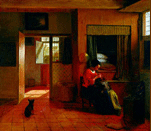










33.
A Woman in a Golden Cage:
Gender within a musically-harmonized Space
Organizers:
Description:
We will begin with no more than ten minutes of introduction, asking participants to introduce themselves and their interest in the workshop, then moving on to group discussion. We envision two 35-minute discussion periods, one focusing on the connection between architectural spaces harmonized through musical proportions, and the object-subject they housed; and the other on a more general level, focusing on the way enclosures and their contents confine women or open opportunities to them. There will be a ten-minute 'wrap-up' period at the end for the group to compare and contrast the different opinions and conclusions on how genres function within art, literature, and music as structural entities which gender subjectivity. To ensure that this workshop is truly a collaborative venture, however, we will encourage participants to come to the workshop with questions on the readings that they would like to have the group address.
A main concern of our workshop is to investigate what can be learned about early modern women and the build environment, by a focus on architectural spaces vs. a focus on its implication on gender. In the first thirty-five minute session we will discuss the musical proportions of beauty applied on architectural spaces (i.e. the vitruvian consideration of 'beauty' as a 'conspiracy of the part in the whole'), in tandem with the particular issue of the palladian golden cage - 'Villa Malcontenta' (Mestre, Venice) - built for Lady Elisabetta Dolfin. This will be only a particular instance, since our main focus will be on the connections between architectural structures based on musical proportions, and their influence on the woman they housed (and consequently on her subjectivity). Isolated from the rest of the urban surrounding, the palladian Villa is just as beautiful as an object (or as a female body), harmonized according to the musical cord of 'C+'. It is also only meant to be looked at, but not to be touched or possessed, because of the outside gardens and bushes, as Elisabetta Dolfin's husband wanted his wife to be. 'How did the spaces Palladio created function as a feminine space? What are the connections between this architectural structure based on the vitruvian concept of 'beauty' and the lady (but maybe nothing but a 'female beautiful body') that was doomed to live there? Was there a code that Palladio was using to speak a certain language, shared by the majority of people, but hard to understand nowadays?' will be the questions at stake in this first part of the session. (Slides of the villa and a practical demonstration, by Dr. Giovanelli, of the musical cord of 'C+' will be offered in this first part).
In the second thirty-five minute session we will discuss the problem of female identity and the way spaces could help shape their subjectivities. AWhat impact did the private spaces a woman lived in have on her personality? How do forms and genres function within art, literature, and music as structural entities which gender subjectivity? Can we really talk about a 'punishment' the fact of living in a beautiful Villa built by one of the most important Italian architect, or could the lady find some happiness even imprisoned in a golden cage? will be the topic for this second session.
While we do not wish to bring workshop participants to any specific conclusion, we hold that an integrative and comparative approach (architectural, musical and literature) focusing on gender and women yields the richest understanding of early modern building environment. We note that one very bizarre palladian villa was build in 1563 under the request of a jealous husband, Nicolò Foscari, who, obsessed by his spouse's libertine behaviour, wanted to segregate her (Elisabetta Dolfin) far from the Venetian social life. Under certain circumstances it seems that the architect wanted to find some parallels between the lady (who was to live there) and the villa itself. Isolated from the rest of the urban surrounding, the Villa is just as beautiful as an object, or as a female body, harmonized according to the musical proportions. This villa is also only meant to be looked at, but not to be touched or possessed (because of the outside gardens and bushes), as Elisabetta Dolfin's husband wanted her to be.
Workshop participants will explore a new methodology for the study of private spaces, asking how architectural and musical analysis can enrich our historical understanding of the experiences of Italian early modern women. A focus on a particular story helps to blur existing boundaries between built environment and literary studies, while at the same time encouraging a critical examination of the historical origins, purposes, and consequences of these boundaries.
Preliminary List of Readings : (40 minutes total)
Suggested Reading:
|
|
|
||||||
|
|
 |
 |
|
||||
 |
|
 |
|
||||
|
|
|
||||||
|
|
|
||||||
 |
|
||||||
|
|
|
||||||
| |
|
||||||
 |
|
||||||
 |
|
||||||
 |
|
||||||
 |
|
||||||
|
|
|
||||||
|
|
 |
|
|
||||
 |
|
||||||
|
|
|
|
|
|
|
|
|